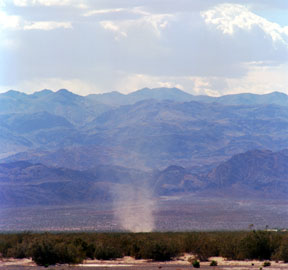Eureka Dunes
In the remote area northwest of Death Valley, lies Eureka Valley, newly-aquired into the Death Valley National Park. On the edge of this valley lie the tallest sand dunes, at over 600 feet, in California (second highest in the United States only to Great Sand Dunes National Monument in Colorado). One interesting note about these dunes is their reputation for making sounds - booming, barking, or singing, when disturbed. The impressive Last Chance Range is in the background.
Print No. A03-24-9
Devils Cornfield
Just to the east of the Mesquite Flat sand dunes, these curious structures are testimony to the survivability of the Arrowweed. As sand dunes gradually built up around them, these plants kept alive by outpacing the rising dunes. Eventually the dunes passed by, exposing the tall root systems of these amazing plants. The ones in this view are over 6 feet (2 meters) tall.
Print No. A99-17-5
Salt Tectonics
In the hottest part of the valley, the surface temperature on the salt flats can exceed 200oF (93oC). Between the temperature extremes and the groundwater that is very close to the surface, the salt flats crack open, expand, and collide like miniature continents subject to plate tectonics. The surface of portions of the salt flats take on the appearance of jagged Alps-like terrain. This area is also known as the Devils Golf Course. (all rough, no greens!)
Print No. A99-29-4
Dust Devil
A little wind shear, with the thermal air convection that's common on the valley floor, and a dust devil is born. Some may be hundreds of feet high.
Print No. A99-28-2
Ubehebe Crater
Located in the northern end of the park, Ubehebe Craters include over a dozen maar volcanoes, eruptions cause by shallow magma contacting groundwater, creating an explosion as the water flashes into steam. These occurred around 3,000 years ago, spewing cinders over an area of 6 square miles (15 Km2). The largest of the craters is Ubehebe Crater at 770 feet (235 meters) deep and 0.5 miles (0.8 Km) across.
Print No. A01-30-3
Steep Alluvial Fan
At the foot of the Grapevine Mountains, northeast of Mesquite Flat, the Furnace Creek Fault drops the valley floor exposing the sheer face of the mountains. In response, sediment spills out of the side canyons over the fault scarp, creating the alluvial fans. The steepness of the fans is indicative of the relative speed of the faulting verses the rate of deposition.
Print No. A99-28-10
Scotty's Castle
Near the remote northeast entrance to the park lies Scotty's Castle, built in the late 1920s by "Death Valley" Scotty and Albert Mussey Johnson. These two characters were brought together as gold investment partners, but in the end, and after little luck with gold prospecting, became lifelong friends with each other and the desert.
Print No. A01-30-4







